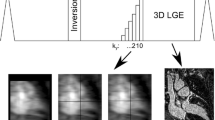Summary
Contrast enhanced (CE) magnetic resonance angiography (MRA) provides high resolution angiograms within 20–40 sec. The technique is based on the acquisition of heavily T1-weighted threedimensional (3D) gradient-echo data sets (FISP) with ultrashort echo- (< 2 ms) and repetition times (< 5 ms) during the arterial phase of an intravenously injected bolus of a T1-shortening agent such as Gd-DTPA. For MR-angiography of abdominal vessels CE-MRA is better suited than “time-of-flight” (TOF) and phase-contrast (PC) MRA because motional artifacts can be obviated with breath-held acquisitions. We have optimised the technique and evaluated its potential for angiography of the abdominal aorta and its branches as well as the portal vein and its tributaries. Whilst CE-MRA provides reliable diagnostic accuracy in the aorta and the proximal sections of its branches, small peripheral arteries cannot be assessed accurately. The portal vein and its tributaries can often be depicted better with CE-MRA than with conventional angiography but, like conventional angiography, CE-MRA is hampered by slow and reversed flow, conditions under which TOF or “true FISP” MRA may perform bst. We have also investigated FLASH-echo-planar imaging (EPI) hybrid techniques, a further technical development which due to shorter acquisition times of 12–15 sec. allows semi-dynamic imaging of the arterial and venous phase and provide better vessel contrast due to the use of fat-suppression.
Zusammenfassung
Die kontrastmittelverstärkte (CE, „contrast enhanced“) Magnetresonanzangiographie (MRA) liefert hochaufgelöste Angiographien innerhalb von 20–40 s. Die Technik basiert auf der Akquisition stark T1-gewichteter dreidimensionaler (3D) Gradientenechodatensätze (FISP) mit ultrakurzen Echo- (< 2 ms) und Repetitionszeiten (< 5 ms) während der arteriellen Phase eines intravenös injezierten Bolus eines T1-verkürzenden Kontrastmittels wie z. B. Gd-DTPA. Für die Angiographie der Abdominalgefäße ist die CE-MRA der „time-of-flight“ (TOF) und Phasenkontrast (PC) MRA überlegen, da Bewegungsartefakte durch Aufnahmen im Atemstillstand fast vollständig vermieden werden. Wir haben die Technik der CE-MRA optimiert und ihr Potential für die Angiographie der Bauchaorta und ihrer Äste als auch des Pfortaderkreislaufs evaluiert. Während die CE-MRA im Bereich der Aorta und der proximalen Abschnitte ihrer Äste zuverlässige diagnostische Informationen liefert, können kleine, periphere Gefäße nicht zuverlässig beurteilt werden. Der Pfortaderkreislauf kann mit der CE-MRA oft besser als mit der konventionellen Angiographie beurteilt werden, ist aber, wie auch die konventionelle Angiographie, durch langsamen Fluß oder Flußumkehr behindert, Umstände, unter denen die TOF oder „true-FISP“ MRA die besten Ergebnisse liefern kann. Wir haben darüber hinaus FLASH-Echo-Planar-Imaging (EPI) Hybridtechniken untersucht, eine technische Weiterentwicklung, die auf Grund der kürzeren Aufnahmezeiten von 12–15 s die semidynamische Abbildung der arteriellen und venösen Phase ermöglicht und durch den Einsatz von Fettunterdrückung einen verbesserten Gefäßkontrast liefert.
Similar content being viewed by others
Author information
Authors and Affiliations
Rights and permissions
About this article
Cite this article
Stehling, M., Holzknecht, N. & Laub, G. Gadolinium-enhanced magnetic resonance angiography of the abdominal vessels. Radiologe 37, 539–546 (1997). https://doi.org/10.1007/s001170050251
Issue Date:
DOI: https://doi.org/10.1007/s001170050251




